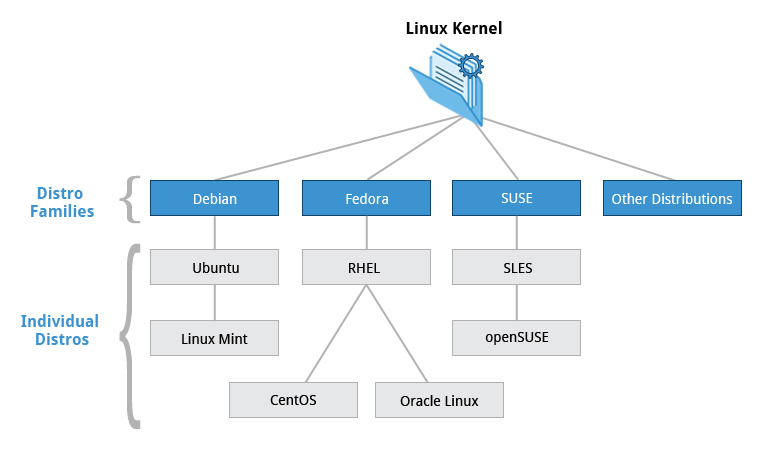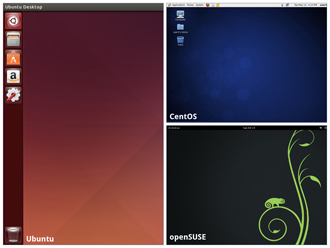"Don't look down others just because those people play fool roles to you", quoted by Kevin.
The Linux Foundation is a nonprofit organization that sponsors the work of Linux creator Linus Torvalds. It was founded in 2000 and its mission is to promote, protect, and advance Linux. The Linux Foundation is active on many fronts. In addition to its basic missions of protecting, promoting and advancing Linux.
The official versions of the Linux kernel are released at www.kernel.org which run the popular website linux.com
******************** Special Thanks ********************
Mats E. who is a humble person.
******************************************************************
Section2 Linux Foundation Training
The Linux Foundation has a copyright on all the materials in this course. Therefore, please checkout at references.
Section3 Course Linux Requirement
The families and representative distributions we are using are:
- Fedora Family Systems (such as CentOS)
- Debian Family Systems (such as Ubuntu)
- SUSE Family Systems (such as openSUSE)
↞ Fedora Family ↠

Fedora forms the basis of Red Hat Enterprise Linux (RHEL), CentOS, Scientific Linux, and Oracle Linux. Fedora contains significantly more software than RHEL. The topper distro has a much longer release cycle than lower one. Let's say REHL releases new version more frequent than CentOS.
CentOS(no cost) is also virtually identical to Red Hat Enterprise Linux, which is the most popular Linux distro in enterprise environments.
Fedora Family uses the RPM-based yum package manager to install, update, and remove packages in the system.
↞ SUSE Family ↠

SUSE Family consists of SUSE Linux Enterprise Server (SLES) and openSUSE. Let's say, SUSE is a set. SLES is subset of SUSE. openSUSE is subset of SLES. It can be implied that subset can apply to its set. Typically, openSUSE is free but SLES is not since it's enterprise version.
Key Facts About the SUSE Family
- SUSE Linux Enterprise Server (SLES) is upstream for openSUSE.
- The Linux kernel 3.11 is used in openSUSE 12.3.
- It uses the RPM-based zypper package manager to install, update, and remove packages in the system.
- It includes the YaST (Yet another System Tool) application for system administration purposes.
- SUSE is widely used in the retail sector.
↞ Debian Family ↠

The Debian distribution is upstream for several other distributions including Ubuntu, and Ubuntu is upstream for Linux Mint and others. It is commonly used on both servers and desktop computers. Debian is a pure open source project and focuses on one key aspect, that is, stability. It also provides the largest and most complete software repository to its users.
Ubuntu aims at providing a good compromise between long term stability and ease of use. Since Ubuntu gets most of its packages from Debian’s stable branch, Ubuntu also has access to a very large software repository. For those reasons, we decided to use Ubuntu 14.04 LTS (Long Term Support) referring to Debian family distribution for the course but Debian-based Kali distro will be used for this blog since I installed it.
Key Facts About the Debian Family
- The Debian family is upstream for Ubuntu, and Ubuntu is upstream for Linux Mint and others.
- The Linux kernel 3.13 is used in Ubuntu 14.04.
- It uses the DPKG-based apt-get package manager to install, update, and remove packages in the system.
- Ubuntu has been widely used for cloud deployments.
- While Ubuntu is built on top of Debian, it uses the Unity graphical interface, is GNOME-based and differs quite a bit visually from the interface on standard Debian as well as other distributions.
More About the Software Environment
The material produced by the Linux Foundation is distribution-flexible. This means that technical explanations, labs, and procedures should work on most modern distributions. While choosing a Linux distribution system, you will notice that the technical differences are mainly about package management systems, software versions, and file locations. Once you get a grasp of those differences it becomes relatively painless to switch from one Linux distribution to another.
The desktop environment used for this course is GNOME since it is the most popular.
Summary
- The Linux Foundation is a nonprofit consortium dedicated to fostering the growth of Linux.
- The Linux Foundation training is for the community and by the community. Linux training is distribution-flexible, technically advanced, and created with the leaders of the Linux development community.
- There are three major distribution families within Linux: Fedora, SUSE and Debian.

Reference:


No comments:
Post a Comment